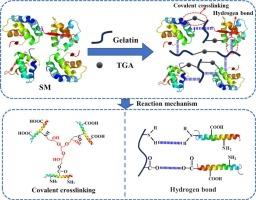A bio-based adhesive based on soy protein-gelatin with high cold compression strength, toughness, and water resistance
IF 6.3
2区 化学
Q1 POLYMER SCIENCE
引用次数: 0
Abstract
In order to reduce the harm of formaldehyde-based adhesives and solve the problem of petroleum resource shortage, green and formaldehyde free bio-based adhesives have great market development potential. Soy protein adhesive is expected to solve these problems, but it has disadvantages such as low cold compression strength and high bonding brittleness, making it difficult to carry out large-scale industrial applications. This study introduced gelatin and triglycerides (TGA) into soy protein (SM) adhesive to construct a double bond composite system. TGA undergoes cross-linking reaction with soy protein to form a cross-linked structure as the skeleton structure, which endows the adhesive with strength and water resistance; and gelatin (Gel) forms hydrogen bonds with soy protein as sacrificial bonds, improving the toughness and cold compression performance of the adhesive. Compared with pure SM adhesive, the dry/wet shear strength of modified SM/2-Gel/TGA adhesive increased by 27.8 % and 400 %, respectively, reaching 2.3 MPa and 1.4 MPa. The moisture absorption rate of the modified adhesive decreased by 16.5 %, the residual rate increased by 10.0 %, and the fracture strain increased by 52.2 % to 14 %. In addition, in the adhesive treated with cold pressing, the lap strength increased by 25.1 % to 4.23 MPa, indicating that the cold pressing strength, bonding toughness, and water resistance of the modified adhesive were effectively improved. This study provides a new way for preparing green, formaldehyde free high-performance bio-based adhesives.

一种基于大豆蛋白明胶的生物基粘合剂,具有高冷压强度、韧性和耐水性
为了减少甲醛基胶粘剂的危害,解决石油资源短缺的问题,绿色无甲醛生物基胶粘剂具有很大的市场发展潜力。大豆蛋白胶粘剂有望解决这些问题,但其冷压强度低、粘接脆性高等缺点,难以进行大规模的工业应用。本研究将明胶和甘油三酯(TGA)引入大豆蛋白(SM)胶中,构建双键复合体系。TGA与大豆蛋白发生交联反应,形成交联结构作为骨架结构,使胶粘剂具有强度和耐水性;明胶(凝胶)与大豆蛋白形成氢键作为牺牲键,提高胶粘剂的韧性和冷压性能。与纯SM胶粘剂相比,改性SM/2-Gel/TGA胶粘剂的干、湿抗剪强度分别提高27.8%和400%,达到2.3 MPa和1.4 MPa。改性胶粘剂的吸湿率降低了16.5%,残余率提高了10.0%,断裂应变提高了52.2% ~ 14%。另外,经冷压处理的胶粘剂的搭接强度提高了25.1%,达到4.23 MPa,表明改性胶粘剂的冷压强度、粘接韧性和耐水性得到了有效提高。本研究为制备绿色、无甲醛的高性能生物基胶粘剂提供了新的途径。
本文章由计算机程序翻译,如有差异,请以英文原文为准。
求助全文
约1分钟内获得全文
求助全文
来源期刊

European Polymer Journal
化学-高分子科学
CiteScore
9.90
自引率
10.00%
发文量
691
审稿时长
23 days
期刊介绍:
European Polymer Journal is dedicated to publishing work on fundamental and applied polymer chemistry and macromolecular materials. The journal covers all aspects of polymer synthesis, including polymerization mechanisms and chemical functional transformations, with a focus on novel polymers and the relationships between molecular structure and polymer properties. In addition, we welcome submissions on bio-based or renewable polymers, stimuli-responsive systems and polymer bio-hybrids. European Polymer Journal also publishes research on the biomedical application of polymers, including drug delivery and regenerative medicine. The main scope is covered but not limited to the following core research areas:
Polymer synthesis and functionalization
• Novel synthetic routes for polymerization, functional modification, controlled/living polymerization and precision polymers.
Stimuli-responsive polymers
• Including shape memory and self-healing polymers.
Supramolecular polymers and self-assembly
• Molecular recognition and higher order polymer structures.
Renewable and sustainable polymers
• Bio-based, biodegradable and anti-microbial polymers and polymeric bio-nanocomposites.
Polymers at interfaces and surfaces
• Chemistry and engineering of surfaces with biological relevance, including patterning, antifouling polymers and polymers for membrane applications.
Biomedical applications and nanomedicine
• Polymers for regenerative medicine, drug delivery molecular release and gene therapy
The scope of European Polymer Journal no longer includes Polymer Physics.
 求助内容:
求助内容: 应助结果提醒方式:
应助结果提醒方式:


